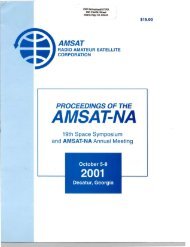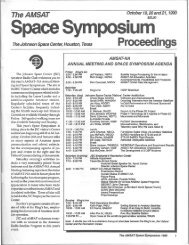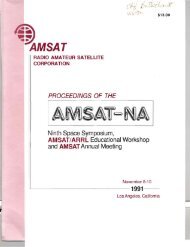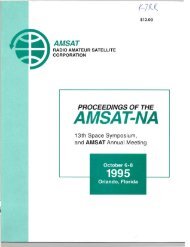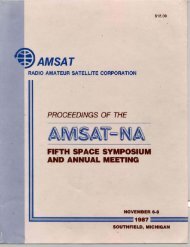October 27-29, 2000 - Klofas.com
October 27-29, 2000 - Klofas.com
October 27-29, 2000 - Klofas.com
You also want an ePaper? Increase the reach of your titles
YUMPU automatically turns print PDFs into web optimized ePapers that Google loves.
3.4 California Polytechnic Institute<br />
3.4.2 PolySat: Cal Ploy's Prototype CubeSat<br />
The Cal Poly prototype CubeSat, PolySat, meets the deployer's constraints for size, mass, shape, and interface. The<br />
putpOse of our prototype is twofold: fITSt, to validate the deployer standard design and second, to demonstrate that<br />
CubeSats provide a viable platfonn for basic experiments in a space environment. PolySat is a minimum<br />
configuration satellite, consisting of a simple set of<strong>com</strong>ponents required to demonstrate low-Earth orbit operation.<br />
PolySat's structure is consistent with the deployer's standard. A 100 mm cube has been designed with the required<br />
guide rails and interface for the deployer. The structure is <strong>com</strong>posed of six individual panels of aluminum 7075-T6,<br />
totaling a mass of 0.2 kg and strong enough to survive launch loads. Mount points for antennas on the exterior and<br />
various internal <strong>com</strong>ponents are provided.<br />
The <strong>com</strong>munications system consists of a downlink transmitter, an uplink receiver, and independent antennas for<br />
each. Downlink is provided by a modified on-board Alinco DJ-C4T 440 MHz amateur radio transmitter. This is<br />
<strong>com</strong>mercially available for $70 retail, and offers 300 mW output, at a cost of 1.11 W when transmitting. It is very<br />
robust and <strong>com</strong>pact. Further, it generates very little heat in operation and has low idling power requirements. Both<br />
our own requirements and FCC amateur regulations demand an independent uplink receiver capable of providing a<br />
minimum of an "off" <strong>com</strong>mand for the downlink transmitter. Requirements analysis revealed that <strong>com</strong>monly<br />
available amateur radio receiving equipment would likely suffer from overload and serious intennodulation<br />
distortion (IMD) from strong earth generated signals on nearby frequencies was solved by using a MICRF004.<br />
This data receiver on a chip (<strong>com</strong>monly used for garage door opener receivers) is from Micrel, Inc. This solution is<br />
quite cheap to implement at about $30. It is easily modified to receive in the 144 MHz amateur radio band with<br />
extremely low power requirements and low sensitivity. Low sensitivity, usually a disadvantage, affords the CubeSat<br />
uplink receiver relative immunity to spurious signals. Compensation is easily provided on earth by increased<br />
amplification and antenna gain with <strong>com</strong>monly available amateur radio <strong>com</strong>ponents. This receiver choice enables<br />
future enhancements for the uplink channel such as reset <strong>com</strong>mand or even simple reprogramming of the onboard<br />
processor.<br />
Independent dipole antennas mounted on one face of the box provide the downlink and uplink capability. The<br />
antenna design mirrors the technique used on OPAL, namely metal "measuring tape" available at any hardware<br />
store. It is flexible, holds its shape well and has served as adequate material on previous missions. The antennas are<br />
folded down against the satellite body with monofilament held down by a short length of nichrome wire. Upon<br />
deployment, a current is passed through the nichrome wire, which will heat the monofilament and release the<br />
antennas.<br />
Figure 3.4.1. The PolySat with Deployed Dipole Antennas<br />
33




